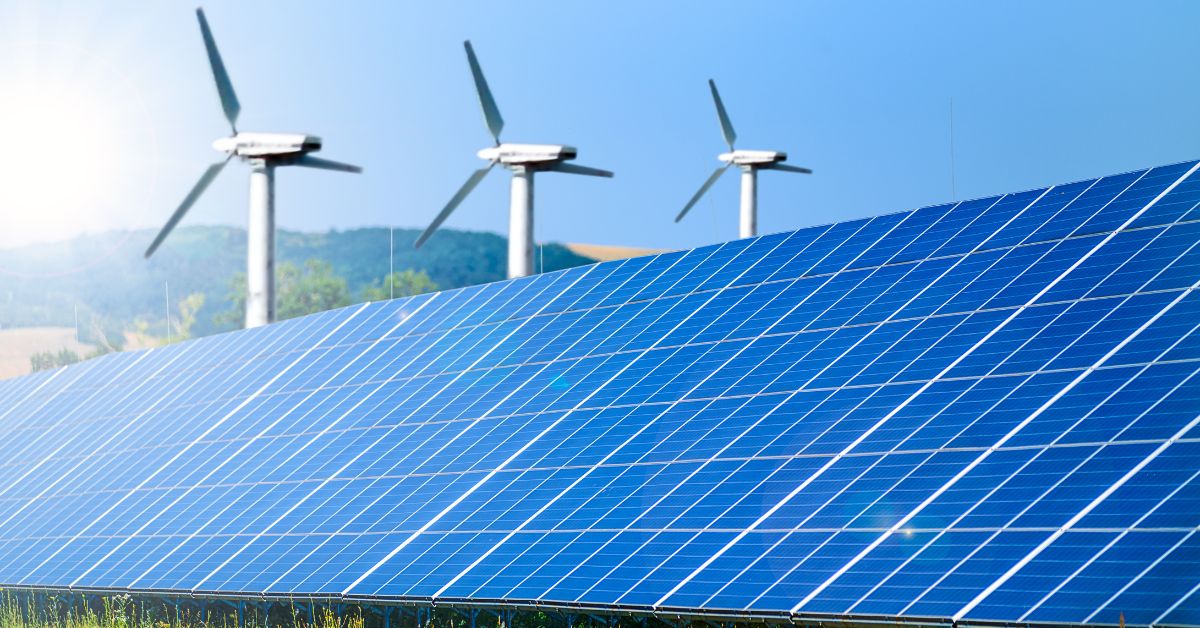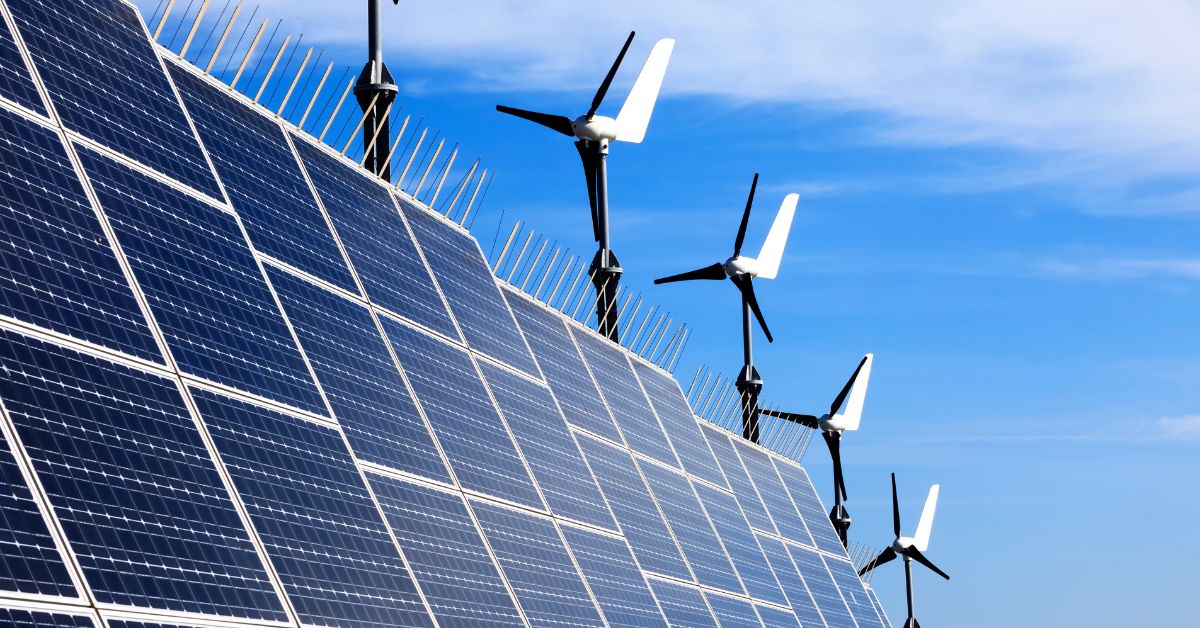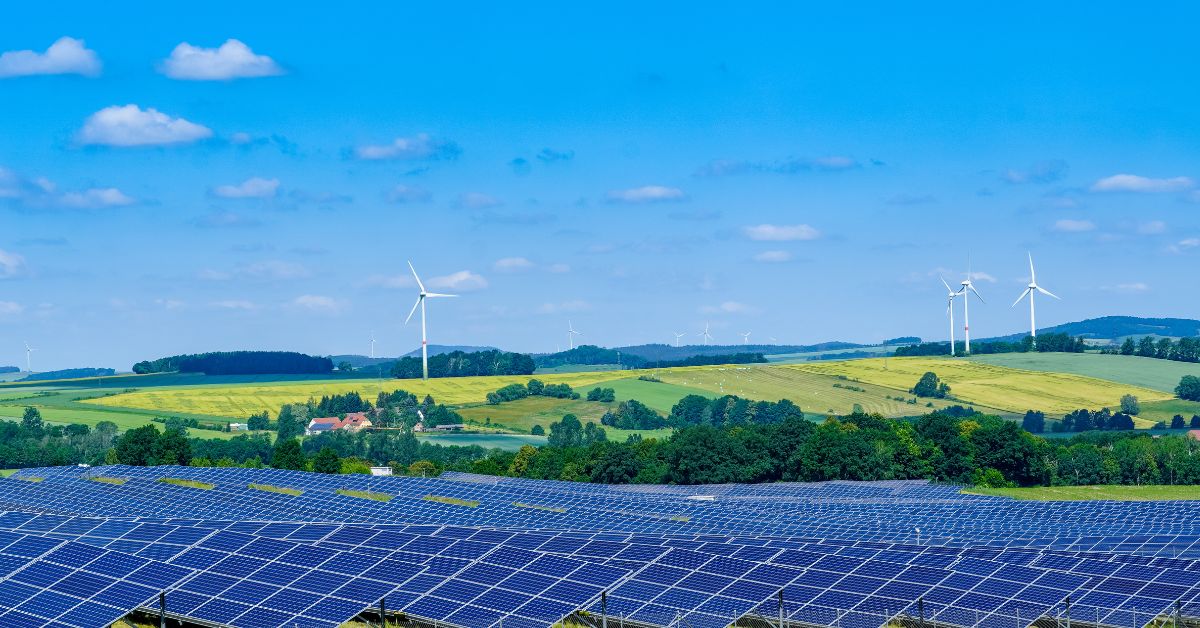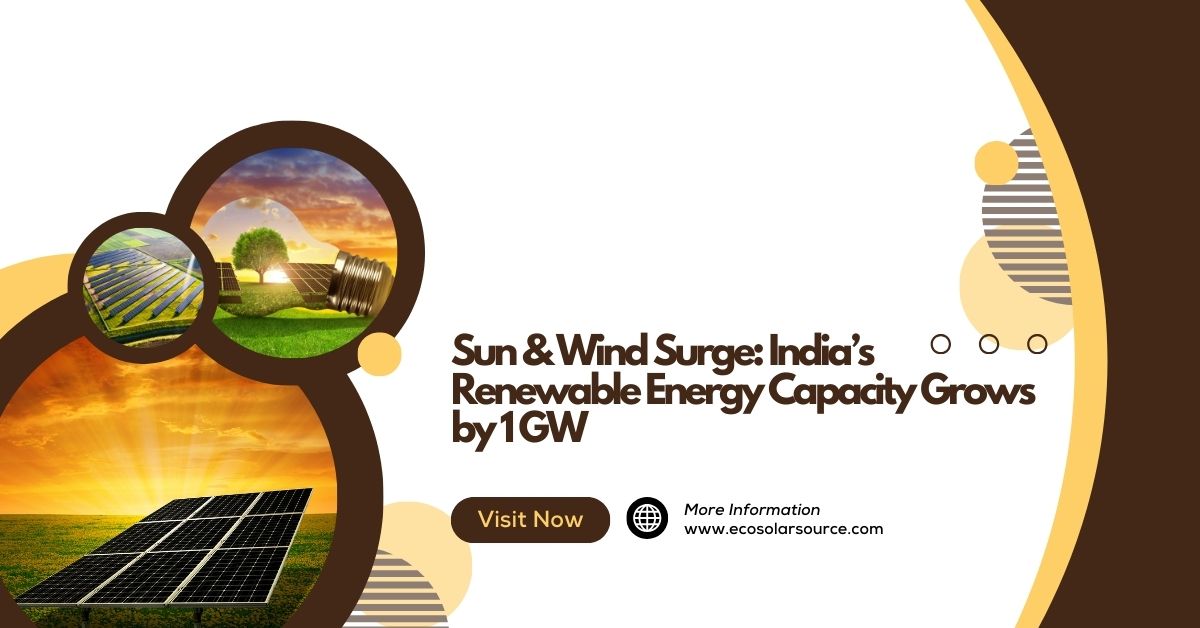Sun Wind Surge Indias Renewable Energy Capacity Grows by 1 GW
Know the details about Sun Wind Surge Indias Renewable Energy Capacity Grows by 1 GW, India’s renewable energy sector just reached a new milestone with the addition of 1 GW of capacity, signaling significant progress in its clean energy ambitions.
Driven by the nation’s commitment to combating climate change, this surge combines the power of solar and wind energy. The expansion reflects India’s ongoing shift toward sustainable energy sources, with investments in large-scale solar farms and wind projects. As the government intensifies efforts to decarbonize the economy, this latest growth highlights the country’s potential to lead in the global green energy transition, reducing reliance on fossil fuels and embracing a greener future.
Table of Contents
Sun Wind Surge Indias Renewable Energy Capacity Grows by 1 GW
India, a country known for its vast landscapes, rich culture, and dynamic economy, is increasingly being recognized for its ambitious strides in renewable energy. With a population of over 1.4 billion people and a rapidly growing demand for electricity, the Indian government has strategically positioned itself as a global leader in the clean energy transition. The country’s renewable energy sector is experiencing a surge in both wind and solar power capacity, as evidenced by the recent milestone of an additional 1 GW (gigawatt) increase in the nation’s renewable energy portfolio. This article delves into the significance of this growth, the challenges faced, and the future of India’s renewable energy ambitions.
Introduction: India’s Renewable Energy Landscape
India’s journey into renewable energy began with a commitment to reduce its dependency on fossil fuels and to meet its climate change goals under the Paris Agreement. With over 40% of its population still relying on traditional forms of energy, primarily coal, the shift towards renewable sources such as wind, solar, and hydropower has been both an economic and environmental necessity.

The country has vast potential in renewable resources, given its geographical advantages. India’s solar energy potential is particularly promising due to its tropical location, which ensures plenty of sunlight throughout the year. Simultaneously, the vast coastline and expansive plains make it an ideal location for wind energy projects. Over the past decade, India has consistently invested in scaling up its capacity for wind and solar power, striving to achieve self-sufficiency while reducing greenhouse gas emissions.
The 1 GW Milestone: What It Means
The recent 1 GW increase in renewable energy capacity is a significant achievement, underscoring the rapid pace of growth in India’s renewable energy sector. A gigawatt is a billion watts, and to put that into perspective, 1 GW of solar energy can power around 750,000 homes annually. Achieving this milestone is not merely a technical victory but a reflection of the political will, economic incentives, and technological advancements driving the renewable energy sector in India.
This 1 GW increase is part of a broader strategy aimed at achieving India’s target of 500 GW of renewable energy capacity by 2030, a commitment made by Prime Minister Narendra Modi. The country’s focus on solar and wind energy is integral to this plan, with significant strides being made in both areas.
Solar Energy: Lighting Up the Future
Solar energy has become a cornerstone of India’s renewable energy strategy. The country is blessed with around 300 sunny days annually, making it an ideal environment for large-scale solar energy projects. Solar power is versatile and can be generated through various means, including rooftop solar panels, solar farms, and concentrated solar power (CSP) plants.
India’s National Solar Mission, launched in 2010, has been a key driver in scaling up the country’s solar capacity. Under this initiative, the government aimed to achieve 100 GW of solar energy capacity by 2022, a target that was recently updated to 300 GW by 2030. While challenges in land acquisition, financing, and grid integration have slowed progress in some regions, the addition of 1 GW to the national grid demonstrates that solar power remains a robust pillar of India’s energy mix.
The Role of Solar Parks
India has adopted the solar park model to harness the sun’s energy on a large scale. These parks are vast areas of land dedicated to solar power generation, housing multiple solar power projects. States like Rajasthan, Gujarat, and Andhra Pradesh are leading the way in solar park development, with Rajasthan’s Bhadla Solar Park being one of the largest in the world.
The Bhadla Solar Park, located in the Thar Desert, spans over 14,000 acres and has a capacity of more than 2.2 GW. It is a testament to India’s commitment to scaling up solar power and has attracted significant investment from private players and foreign investors.
Rooftop Solar: A Decentralized Approach
While large solar parks are crucial for meeting India’s energy demands, rooftop solar power is gaining popularity due to its decentralized nature. Households, businesses, and public institutions are increasingly installing solar panels on rooftops to reduce their reliance on the national grid and lower electricity bills. The government has introduced several incentives to promote rooftop solar installations, including subsidies, tax benefits, and easier access to financing.
The decentralized approach is particularly important in rural areas, where access to electricity remains a challenge. By promoting rooftop solar installations, the government aims to bridge the energy gap and ensure that even the most remote regions have access to clean, reliable energy.
Wind Energy: Harnessing the Power of Nature
India’s wind energy sector has also experienced significant growth, contributing to the overall 1 GW increase in renewable capacity. India is currently the world’s fourth-largest wind power producer, with states like Tamil Nadu, Gujarat, and Karnataka leading in wind energy generation.
The country’s wind energy potential is immense, particularly in the southern and western regions, which experience strong and consistent winds. To harness this potential, India has been focusing on both onshore and offshore wind energy projects.
Onshore Wind Energy
Onshore wind farms have been the backbone of India’s wind energy sector. These farms are typically located in regions with high wind speeds, such as Tamil Nadu’s Aralvaimozhi Pass and Gujarat’s coastal areas. The government has actively supported the development of onshore wind farms through policies like the Generation-Based Incentive (GBI) and tax exemptions for wind energy producers.
One of the most notable onshore wind farms in India is the Muppandal Wind Farm in Tamil Nadu, which has a capacity of 1,500 MW, making it one of the largest wind farms in Asia. Projects like this have played a critical role in adding to the national grid and meeting the growing energy demands of the country.
Offshore Wind Energy: The Next Frontier
While onshore wind energy has dominated India’s wind power sector, offshore wind energy is emerging as the next frontier. Offshore wind farms are located in the ocean, where wind speeds are generally higher and more consistent, resulting in greater energy generation potential.
India has significant offshore wind potential, particularly along its 7,500 km coastline. The government has identified several zones for offshore wind energy development, particularly off the coasts of Gujarat and Tamil Nadu. The first offshore wind energy project, a 1,000 MW wind farm in the Gulf of Khambhat, is currently in the planning stages. If successful, this project could pave the way for a new era of wind energy generation in India.
Government Policies Driving Renewable Energy Growth
India’s rapid renewable energy growth is largely due to a favorable policy environment created by the government. Over the past decade, various initiatives and policies have been introduced to promote renewable energy investment, reduce the country’s carbon footprint, and provide reliable electricity to its citizens.

National Solar Mission
As mentioned earlier, the National Solar Mission has been a cornerstone of India’s solar energy push. Launched in 2010, the mission originally aimed for 100 GW of solar capacity by 2022. This goal was later revised to 300 GW by 2030, reflecting the government’s confidence in the solar sector’s potential.
Renewable Purchase Obligations (RPO)
The Renewable Purchase Obligations (RPO) mandate requires electricity distribution companies to purchase a certain percentage of their power from renewable sources. This policy has been crucial in driving demand for renewable energy and ensuring that it is integrated into the national grid.
Green Energy Corridors
The Green Energy Corridors initiative aims to strengthen the transmission network for renewable energy projects. It involves the construction of high-voltage transmission lines and substations to ensure that renewable energy, particularly from remote areas, can be efficiently transmitted to regions with high demand. The project is being implemented with financial assistance from international organizations like the World Bank and the Asian Development Bank.
Incentives for Private Investment
India’s renewable energy sector has attracted significant investment from both domestic and international players. The government has introduced several incentives to encourage private investment, including tax exemptions, subsidies, and viability gap funding (VGF). These incentives have helped make renewable energy projects financially viable and have attracted companies from around the world to invest in India’s clean energy future.
Challenges and Roadblocks
Despite the rapid growth of the renewable energy sector, India faces several challenges that must be addressed to sustain this momentum. These challenges include issues related to land acquisition, grid integration, financing, and policy implementation.
Land Acquisition
One of the most significant challenges in scaling up renewable energy projects is acquiring the land needed for large solar parks and wind farms. India is a densely populated country, and land is often contested, with multiple claims and competing uses. This has led to delays in project implementation and increased costs for developers.
Grid Integration
As India increases its renewable energy capacity, integrating this power into the national grid presents another challenge. Renewable energy is intermittent by nature – solar power is generated only during daylight hours, and wind power depends on weather conditions. This intermittency makes it difficult to maintain a stable supply of electricity, especially when the demand is high.
To address this issue, India is investing in energy storage solutions, such as battery storage systems, and upgrading its grid infrastructure. The Green Energy Corridors initiative mentioned earlier is a critical part of this effort, as it aims to strengthen the transmission network for renewable energy projects.
Financing
While India has attracted significant investment in its renewable energy sector, financing remains a challenge, particularly for smaller projects and developers. Many renewable energy projects require large upfront investments and access to affordable financing can be difficult, especially in rural areas. The government has introduced several schemes to provide financial support, but more needs to be done to ensure that all projects have access to the necessary funds.
Policy Implementation
India’s renewable energy policies are ambitious, but implementation can be inconsistent across different states. Some states have been more proactive in promoting renewable energy, while others have been slower to adopt new technologies and integrate them into their energy mix. This disparity in policy implementation has created challenges for developers and investors, who must navigate a complex regulatory environment.
The Road Ahead: India’s Renewable Energy Future
India’s renewable energy sector is poised for continued growth in the coming years. With a target of 500 GW of renewable energy capacity by 2030, the country is well on its way to becoming a global leader in clean energy. However, to achieve this goal, India must overcome the challenges outlined above and continue to invest in innovative solutions.

Focus on Energy Storage
Energy storage will play a critical role in the future of India’s renewable energy sector. As the country increases its reliance on solar and wind power, the need for reliable energy storage solutions becomes more urgent. Battery storage systems, pumped hydro storage, and other technologies will be essential for ensuring a stable supply of electricity and overcoming the intermittency of renewable energy sources.
International Collaboration
India’s renewable energy ambitions have attracted the attention of the international community, and collaboration with other countries will be crucial for achieving its goals. The International Solar Alliance (ISA), an initiative launched by India and France, aims to promote solar energy development worldwide and provide a platform for countries to share knowledge and resources.
Innovation and Research
To stay at the forefront of the global clean energy transition, India must continue to invest in research and development. Innovations in solar panel efficiency, wind turbine technology, and energy storage systems will be critical for reducing costs and improving the performance of renewable energy projects.
FAQs About Sun Wind Surge Indias Renewable Energy Capacity Grows by 1 GW
Q1. What does the 1 GW capacity growth signify for India’s renewable energy sector?
The 1 GW growth in renewable capacity highlights India’s commitment to transitioning to green energy, contributing to its ambitious goal of achieving 500 GW of non-fossil fuel energy by 2030.
Q2. Which renewable energy sources contributed to this 1 GW capacity increase?
Primarily, solar and wind energy are the largest contributors to this surge, reflecting the country’s ongoing focus on harnessing its abundant sunlight and favorable wind conditions.
Q3. What is the total installed renewable energy capacity of India after this 1 GW increase?
As of now, India’s renewable energy capacity exceeds 123 GW, with solar and wind energy contributing the lion’s share, along with contributions from hydro and biomass sources.
Q4. How does this 1 GW growth align with India’s global climate commitments?
This growth is a step towards India’s pledge under the Paris Agreement to reduce its carbon emissions intensity by 33-35% by 2030 and its ambitious target to achieve net-zero emissions by 2070.
Q5. Which regions in India have seen the most significant growth in renewable energy capacity?
States like Gujarat, Rajasthan, Tamil Nadu, and Karnataka have led the way due to their geographic advantages in solar and wind energy production.
Q6. What impact does this growth have on India’s energy mix?
The increase diversifies India’s energy mix, reducing dependency on coal and fossil fuels, enhancing energy security, and promoting cleaner, more sustainable energy sources.
Q7. How does this 1 GW surge affect job creation in the renewable energy sector?
The expansion in renewable energy projects is expected to create numerous green jobs, especially in rural and semi-urban areas, providing a boost to employment and local economies.
Q8. What are the challenges India faces in sustaining this renewable energy growth?
Key challenges include grid integration, storage solutions, land acquisition, and policy consistency, along with financing and investment bottlenecks.
Q9. How does this growth contribute to reducing carbon emissions in India?
Every GW of renewable energy added helps displace fossil fuel-based power, potentially reducing millions of tons of carbon emissions annually, contributing to India’s cleaner air and lower pollution levels.
Q10. What role do international collaborations play in this surge in renewable energy?
India’s growth is supported by international investments, technology transfers, and collaborations with countries leading in renewable energy innovations, helping India access advanced technology and financing options.
India’s renewable energy sector is experiencing a remarkable surge, with the recent 1 GW increase in capacity marking a significant milestone in the country’s clean energy transition. As India continues to invest in solar and wind power, the country is well-positioned to meet its ambitious renewable energy targets and reduce its carbon footprint.
However, challenges remain, and addressing issues like land acquisition, grid integration, and financing will be critical for sustaining this momentum. With strong government support, international collaboration, and a focus on innovation, India has the potential to become a global leader in renewable energy, setting an example for other nations to follow.
As the world faces the urgent challenge of climate change, India’s efforts in scaling up renewable energy capacity provide a beacon of hope. The sun and wind are powering a new era of clean, sustainable energy, and India is at the forefront of this global movement.
Click here to learn more about Sun Wind Surge Indias Renewable Energy Capacity Grows by 1 GW
Click here to learn more about Solar EPC Contractor Companies in Gujarat

